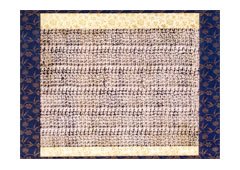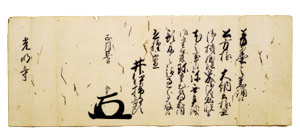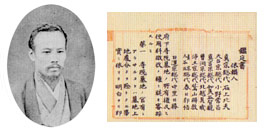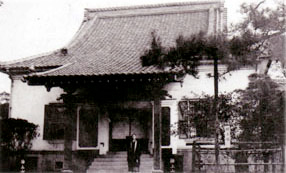Chronologies and Items
The Story of Komyoji

Komyoji Engi, or The Story of Komyoji Temple, was transcribed by the 25th Head Priest of Komyoji Temple in 1776. It mentions the origins of the Statue of Amida-Buddha and the Apricot of Komyoji. Although the Great Kanto Earthquake and the World War II unfortunately destroyed most of the historycal items in Komyoji Temple, this Komyoji Engi tells us the history of the temple.
1200-1600
Daily Nembutsu of Ieyasu Tokugawa

This ancient paper is filled with numerous Nembutsu or "Namo-Amidabutsu" words. Ieyasu Tokugawa, the 1st Shogun of government of Edo(1542-1616), wrote it on the advice of a high priest.
| 1212 | At Sakurada-Kasumigaseki, Shinshikizan Jorakuji Temple(the former name of Komyoji Temple) was established by a Tendai Buddhist monk, Ryo-ei. One legend suggests it was in 1250. |
| 1226 | Influenced by Shinran-Shonin who visited Kanto area, Ryo-ei converted from Tendai-Buddhism to Shin-Buddhism or Pure Land Buddhism. |
| 1540 | According to legend, the Statue of Amida-Buddha of Jorakuji Temple saved people's lives from the plague, shining with the special brilliant light or Komyo. After this episode, Jorakuji Temple was renamed Komyoji Temple. |
| 1590 | When Shogun Ieyasu Tokugawa inaugurated the government of Edo, Kosho who was the 17th Head Priest of Komyoji temple presented a gift of an apricot and poem to Ieyasu. Ieyasu was profoundly moved and called the apricot "The Apricot of Fortune". Subsequently, Ieyasu bestowed a Japanese Large Sword on Kosho. |
1600-1800
Letter of Naohide Ii

This is the letter of Naohide Ii who served as Tairo of the government of Edo. Naohide Ii was the 13th president of clan of Hikone and had served as Tairo for four years since 1784.
| 1604 | In order to extend the site of Edo Castle, the government ordered Komyoji Temple to move from Sakurada-Kasumigaseki to Nishinokubo, where the current Komyoji Temple Tokyo is located. |
| 1645 | When the 3rd Shogun Iemitsu Tokugawa visited Komyoji Temple, he was delighted to hear his grand father's episode and ordered Komyoji Temple to rename its Head Name from Shinshikizan to Baijouzan or "The Temple of Apricot". |
| 1772 | In Meiwa Era, a huge fire burned most of the buildings in Komyoji and killed many people who seek refuge in Komyoji. Shozan, the 24th Head Priest, set up "The Grave of Burned People" in commemoration of the fire casualty. The grave still remains in the site of Komyoji Temple Tokyo. |
| 1792 | Unshitsu, the Artist Monk, entered Komyoji Temple as the 26th Head Priest. |
1800-1900
Hokuten Iwagami

In the first year of the Meiji era, Buddhists and temples over the country were heavily clamped out. Hokuten Iwagami, the 29th Head Priest of Komyoji Temple, played an important role in revitalizing the Buddhism world as a representative of Hongwanji Temple.
| 1832 | Shigejiro Izumiya dedicated a stone pot inscribed "Baijouzan" or the Head Name of Komyoji. It still remains in Komyoji Temple Tokyo. |
| 1880 | Hokuten Iwagami, born in Toyama prefecture, entered Komyoji Temple as the 29th Head Priest. |
| 1894 | The main building in Komyoji Temple was burned in 10th April. |
1900-Present
Kodai-e by Shikou Munakata

"Kodai-e", also known as Amida-Buddha, means the virtue of pure land which attracts many people. Shikou Munakata, a famous woodblock artist (1903-1975), created many works of Shin-Buddhism. This block print was endowed in 1963 from a temple linked to him in Toyama prefecture. It still remains in Komyoji Temple Tokyo.
| 1915 | The buildings of Komyoji Temple Tokyo were completed. The facade below. |
| 1923 | The Great Kanto Earthquake triggered a huge fire and it burned the buildings of Komyoji Temple Tokyo. |
| 1945 | Massed air raids in the World War II burned out the temporary main hall of Komyoji Temple in 10th March. Sawada, one of a member family of Komyoji Temple, assumed the role of temporary temple. |
| 1949 | Komyoji Temple Tokyo established a kindergarten in the site. It was closed In 1966. |
| 1970 | The current buildings of Komyoji Temple Tokyo were completed. |
| 1972 | Komyoji Temple Tokyo set up a branch in Kimitsu city, Chiba prefecture. |
| 19-- | The Kimitsu branch set up for itself and started its own operation as Komyoji Temple Chiba. |
| 1997 | Komyoji Temple Tokyo set up a branch in Soka city, Saitama prefecture. |
| 2008 | The Soka branch set up for itself and started its own operation as Komyoji Temple Saitama. |



